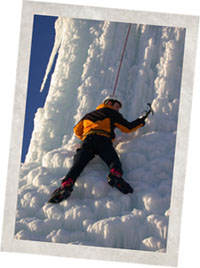Ice climbing in the Canadian Rockies

Some of the best ice climbing in the world can be experienced in the Canadian Rockies around the Canmore, Banff, Kananaskis and Lake Louise area.
With reliable conditions, lots of areas and routes the Canadian Rockies offer a complete range of difficulty and challenge for the novice through to the extreme climber.
Companies in the area offer courses to get you started, skills upgrading or private guides, although make sure that the company you are intending to use for tuition or private guiding provides Instructors that are certified guides/climbers.
Canmore Ice Climbing Festival
Check our events page for more details of ice climbing events.
Ice climbs in the Canmore, Banff, Kananaskis and Lake Louise area:
The climbs listed below are not the only climbs in the Canadian Rockies. There are many many more, from no-approach beginner routes to expert multi-pitch challenges, with most of them located right off or near the highway, plus a lot of remote hidden gems.
- Canmore Junkyards, total height: 30m (98ft), technical grade: WI 2-3
- Cascade Falls, total height: 300m (975ft), technical grade: WI 3
- Grotto Falls, total height: 55m (179ft), technical grade: WI 3
- Heart Creek, total height: 30m (98ft), technical grade: WI 3
- His and Hers, total height: 20m (65ft), technical grade: WI 4
- Johnston Canyon, total height: 30m (98ft), technical grade: WI 4
- Chantilly Falls, total height: 100m (325ft), technical grade: WI 2
- Cobra Verde, total height: 250m (812ft), technical grade: WI 3
- King's Creek, total height: 45m (146ft), technical grade: WI 2-3+
- Marshall Arts, total height: 60m (195ft), technical grade: WI 3-R
- R&D, total height: 90m (292ft), technical grade: WI 4
- Snowline, total height: 100m (325ft), technical grade: WI 4
- Trick or Treat, total height: 70m (227ft), technical grade: WI 4
- Louise Falls, total height: 110m (357ft), technical grade: WI 4+
Basic equipment list
Generally if you are having lessons, or attending a course then you may be able to hire the equipment required, however please check before turning up to avoid disappointment.
A very basic equipment list for ice climbing (not exhaustive by any means) should comprise:
- Belay device/descender
- Boots, double plastic mountaineering boots
- Crampons, must fit your boots or be easily adjustable
- Climbing harness
- Climbing helmet
- Daypack, large enough for spare clothing, food & climbing gear e.g. rope, crampons etc
- Ice tools (2)
- Pocket knife
- Sun cream
- Sunglasses
- Thermos flask and/or water bottle (make sure they're full)
Basic clothing list
Unless you're already a very competent/confident ice climber there may be periods where you are inactive in very cold temperatures. This is one of those times when 'more' is better than 'less'. Make sure you carry light clothing of varying thicknesses so that you can 'layer' to make sure that you keep as comfortable and versatile as possible. Avoid cotton clothing as it will cause rapid heat loss when when (sweaty), choose items that are rapid wicking.
A very basic clothing list for ice climbing (again not exhaustive and dependent on your abilities to some extent) should comprise:
- Fleece jacket, heavyweight
- Insulated jacket or vest
- Knee length gaiters
- Long underwear, top & bottom (fleece, polypro or wool)
- Neck tube
- Socks, 2 sets (wool outer & polypro liner)
- Sweater, medium or lightweight
- Warm pants, preferably fleece or insulated
- Warm shirt
- Waterproof climbing gloves &/or mitts plus spares
- Waterproof jacket with hood (Gore-Tex or nylon)
- Waterproof pants (Gore-Tex or nylon)
- Wool or fleece hat that will cover ears & fit under helmet
